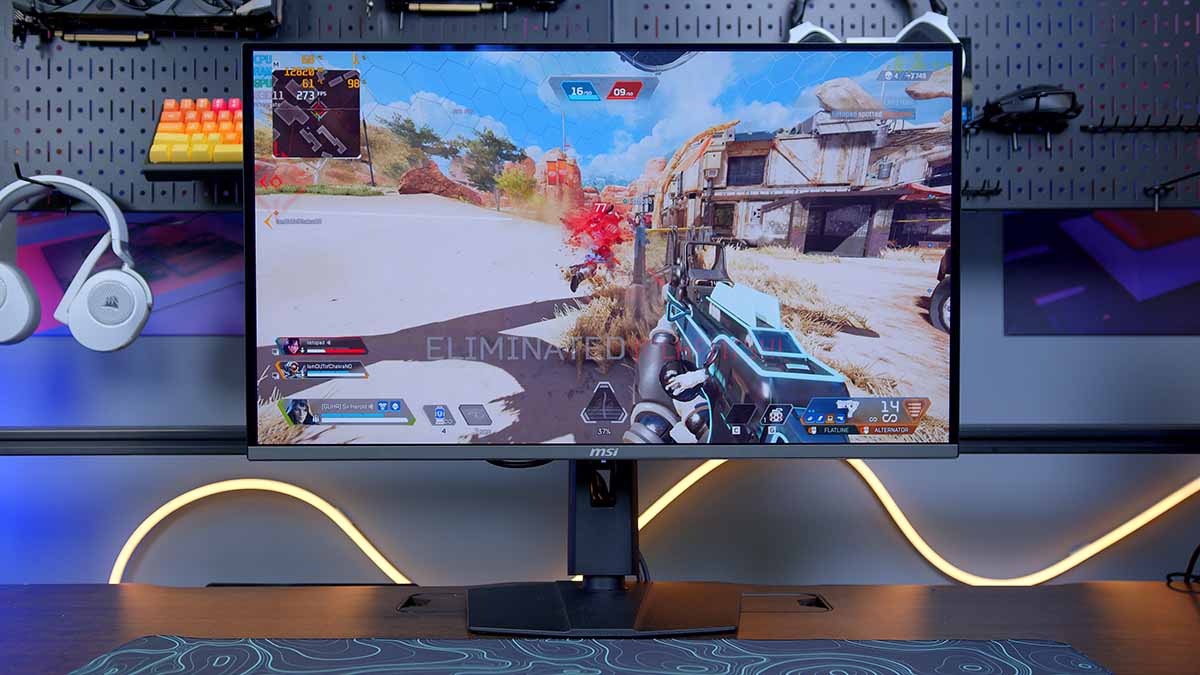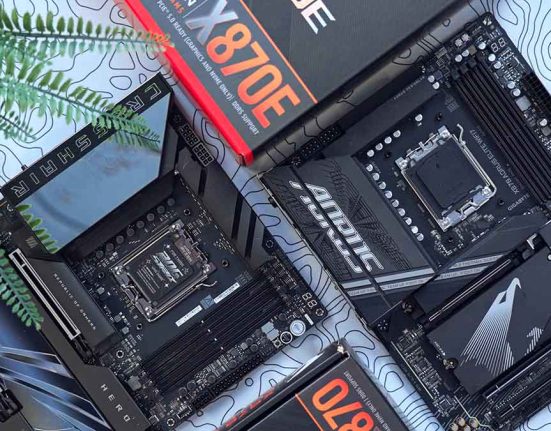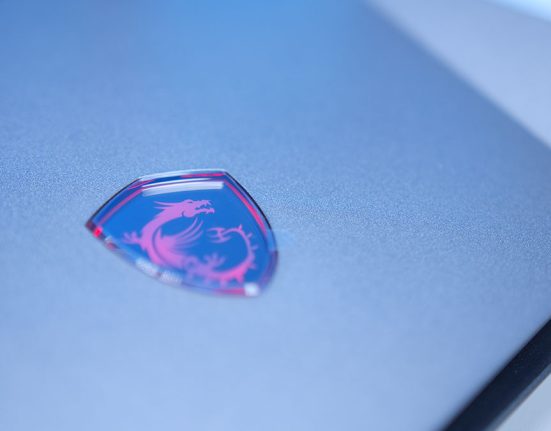The MSI MPG 321URX QD-OLED is an insane gaming monitor offering a sleek and premium design and exceptional visuals to provide an authentic cinematic experience. As display technology has advanced, the PC gaming market has seen a range of new QD-OLED displays enter the scene, all competing to achieve the greatest combination of fidelity and responsiveness. To see how the MSI MPG 321URX QD-OLED compares to the vast selection of existing top-end monitors, we’ve tested it rigorously in various benchmarks to assess image quality, clarity and colour accuracy.
While the MPG 321URX QD-OLED is a tantalising monitor, we’re curious to see what it brings to the table versus other QD-OLED displays we’ve reviewed. MSI boasts that this 3rd-Gen QD-OLED panel ensures exceptionally vivid imagery and mitigates motion blur, so it’ll be interesting to see whether the MPG 321URX QD-OLED stands out in such a competitive market. To determine how this monitor holds up, we’ve looked in-depth at the specs, design, features and performance, assessing the key characteristics to determine its value.


Buy the MSI MPG 321URX QD-OLED on:
Specification
Glancing at the specs, the MSI MPG 321URX QD-OLED is a 31.5-inch display with a rated resolution of 3840 by 2160 pixels, which is 4K. Larger monitors at 4K tend to suffer on the fidelity front as the pixels become more spaced out. However, because the MPG 321URX QD-OLED is utilising a QD-OLED panel, the pixels are microscopic and have their own individual brightness control, so there’s no negligible loss of quality, and there’s more screen space compared to a 27-inch monitor.
Regarding speeds, the MPG 321URX QD-OLED has a 240Hz refresh rate and a 0.03ms response time according to the GtG (grey-to-grey) measurement, which is very accurate to hardware level responsiveness. I’m pretty impressed with the speed of this monitor, as 4K monitors for the past few years have been stuck at the 144Hz mark, with generally higher response times surpassing 1ms. While few will be able to utilise the 240Hz due to framerate limitations, it’s still great to see the tech evolving.
Peak brightness sits around 1000 nits, which most modern QD-OLED monitors offer. Typical brightness is much lower at 250 nits, reducing burn-in effects over prolonged usage. The contrast ratio of this monitor is 1.5 million to one, indicating exceptional accuracy of colours. The contrast ratio generally shows the range between the brightest white and deepest dark, so a high ratio indicates a stronger picture quality.
| Key Specs | MSI MPG 321URX QD-OLED |
|---|---|
| Screen Size | 31.5″ |
| Max Resolution | 3840 x 2160 |
| Refresh Rate | 240Hz |
| Response Time | 0.03ms GtG |
| Colour Gamut | 97% Adobe RGB 99% DCI-P3 138% sRGB |
| Peak Brightness | 1000 nits |
| Contrast Ratio | 1500000:1 |
| Panel Type | QD-OLED |
| Display Inputs | 2 x HDMI 2.1 1 x Displayport 1.4 1 x USB Type-C (DP Alt) |
| Additional IO | 2 x USB 2.0 Type-A Downstream 1 x USB 2.0 Type-B Upstream 1 x Earphone Jack |
| VRR Technology | G-Sync Compatible |
On the IO front, the MPG 321URX QD-OLED has four display inputs, two HDMI 2.1 ports, a Displayport 1.4 port and a USB Type-C port, which offers a Displayport alt mode or 90W power delivery. Also, this monitor provides a couple of USB 2.0 Type-A ports for any peripherals. It is convenient for those without easily accessible case IO, regardless of the slow speeds.
With an MSRP of $949, we were pretty taken aback by the price. While a couple of similar displays on the market sit below the $1000 mark, it’s relatively rare for 4K QD-OLED monitors to be less than $1000. Still, the sub-$1000 price point demonstrates solid value just from looking at the specs alone.
Suggested Article: MSI MAG 274QRFW Gaming Monitor Review
MSI MPG 321URX QD-OLED Design
MSI’s newer gaming monitors have seen more refinement in terms of design, with the loud red stands and RGB lighting getting swapped out for an entirely black or white chassis. The MSI MPG 321URX QD-OLED employs the signature office-style look comprising a black plastic case and stand. However, this display has a much thinner frame than their other options. The sides and top of the MPG 321URX QD-OLED are less than a centimetre thick, resulting in an incredibly skinny look.

While the bottom part of the frame is a little bit chunkier, the grey bar adheres to the sophisticated look that this monitor is going for. The gritty black plastic pops up again on the monitor’s rear, but the thin frame persists, which is a nice touch. Towards the central portion of the rear, you’ll find a small strip of RGB between two grilles and the black dragon MSI logo.

The MSI MPG 321URX QD-OLED stand is also black, with a plastic outer shell covering the base and the pillar. It would be nice to see more metal across the design, as the plastic casing makes this display look cheap compared to other models we’ve tested. It’s also worth noting that the stand has a small cutout in the centre towards the bottom, allowing you to thread any cables through.

It’s also worth noting that the included stand is an optional accessory, as this display comes with a 100 x 100mm VESA mount. This allows those with monitor arms or a wall-mounted setup to maintain clean desk space.

Regarding adjustability, the display offers 15 degrees of tilt, 30 degrees of swivel, 10 degrees of pivot, and 110mm of height adjustment, allowing you to find the perfect viewing angle.

Contrasting to the MSI ‘274’ range, the OSD (on-screen display) joystick has been moved to the centre of the monitor just under the MSI logo. This position is much easier to access compared to the joystick being on the right side, and I have to say I’m a fan of the relocation. Next to the joystick are two buttons, the left of which turns the monitor on and off, while the right is a macro key that only works when the USB Type-B cable is plugged in.

Much like other MSI monitors we’ve tested, the OSD on the MPG 312URX QD-OLED is straightforward to navigate. Clicking on the joystick brings up the more expansive menu, providing various customisable settings. “Gaming Intelligence” (GI) offers the KVM switch, a crosshair, and a scope. The “Gaming” and “Professional” tabs provide a way to change colour presets and enable Night Vision, which brightens the display in darkness. These tabs also feature refresh rate, Adaptive-Sync, and Low Blue Light mode.

Further tabs allow you to change the brightness and contrast settings, input sources, picture-in-picture (PIP) or picture-by-picture (PBP) modes, OLED Care, basic settings like language, and a way to reset the display back to factory defaults.

Features We Like
Exceptional Image Quality
Quantum Dot-OLED is the holy grail of image quality compared to other panels. For this reason, the MSI MPG 321URX QD-OLED is one of the best displays purely from a fidelity standpoint. Black looks incredibly dark, while whites are vibrant and bright across games and other content. Even with the ‘Low Blue Light’ mode enabled, this monitor continues to impress me with its image quality.

This is further complimented by the blazing-fast response time and refresh rate, which allows the MPG 321URX QD-OLED to thrive in a competitive game setting without sacrificing image quality.
Software Control through Gaming Intelligence
As we’ve discussed in our review of the MSI MPG 274URF QD, MSI’s Gaming Intelligence is surprisingly good. The only requirement for using it is to plug in the included USB Type-B cable, allowing you to access the USB ports on the back of the display. Gaming Intelligence provides a way to control and customise individual monitor settings through a single application.
This saves a lot of hassle, as there’s no reason to scroll through the menus with the OSD joystick. All of the settings are available through a simple-to-use application. Gaming Intelligence provides several settings that will change the colour and brightness preset. The rest of the customisation options are available through the “Standard” tab, while the PIP and PBP modes are in the “Split Window” tab.
Customisable Aspect Ratio
The MSI MPG 321URX QD-OLED offers a way to change the aspect ratio from a traditional 16:9 to 16:10 or 4:3. Most displays lock this feature as it might not serve as much of a benefit for most setups. However, those with smaller monitors may want to adjust the aspect ratio so that the screen better aligns with their existing displays. This is accessible through the OSD or can be changed using the Gaming Intelligence app.

OLED Care
Another useful feature found in the OSD is the “OLED Care” tab. Because OLED panels use natural materials, these screens are more susceptible to burn-in, so manufacturers have developed several ways to reduce damage to OLED panels through various techniques. This includes dimming zones, turning off the display over a certain amount of time, or even cleaning the pixels.

While the OLED Care tab is hidden at the bottom of the OSD, MSI has included various settings to ensure the OLED panel on this display remains in tip-top shape.
90W Power Delivery
You’ll find a USB Type-C port on the IO, which acts as a Displayport Alt input or a 90W power delivery port. This is aimed at those with laptops or portable setups, as this port allows for quick charging and as a display input simultaneously.

Features We Don’t Like
Feels Quite Cheap
Overall, I feel the aesthetic and the price point of the MSI MPG 321URX QD-OLED don’t match. While this is one of MSI’s better-looking displays, it comes in at a very high price point, near the $1000 mark, so for this, we’d expect less plastic and more premium materials. This isn’t a deal-breaker for us, but we imagine this will be a point of contention for some prospective buyers expecting a bit more in terms of the aesthetic at this price point.

Colour Accuracy & Image Quality
To determine how colour-accurate the MSI MPG 321URX QD-OLED is, this monitor has been tested over a few days to assess the performance, smoothness, visual fidelity and colour accuracy. Through gaming and day-to-day usage, it is evident that MSI has prioritised responsiveness, as this monitor outshines the competition on speed alone.
To see what the MPG 321URX QD-OLED offers in terms of colour accuracy, we fired up the DataColor Spyder X Pro calibrator. This application and hardware assess colour gamut coverage and calibrate the display to represent colours better. Doing this lets us see if MSI’s advertised ratings are accurate.

Across the sRGB gamut, as you can see from our data, pretty much every modern monitor, including the MPG 321URX QD-OLED, can cover the sRGB space with no issues. There are very few current-gen monitors that aren’t able to hold their own in this colour gamut.
Moving over to DCI-P3, the MPG 321URX QD-OLED provided 97% coverage of this gamut, 2% less than the advertised rating of 99%. Ultimately, the difference here is negligible; we’d put this down to testing conditions. Finding the right light setting for colour calibration can be very difficult, which might be why we’re seeing a slightly different result. Regardless, the 97% coverage is ideal for those who work with and consume HDR content.

Conclusion
MSI MPG 321URX QD-OLED

Product Name: MPG 321URX QD-OLED
Brand: MSI
-
Features
-
Design
-
Performance
-
Value For Money
Summary
The MSI MPG 321URX QD-OLED is one of the strongest modern displays we’ve tested recently. This 3rd-gen QD-OLED panel brings exceptional performance and a massive range of features, which includes blazing-fast response times, crisp and vibrant colours, and a range of ways to protect and reduce burn-in with the click of a button. Furthermore, the MPG 321URX QD-OLED comes with additional gaming and professional-focused features, such as the KVM switch or smart crosshair, which further increases the value for those with multifaceted setups. To top it all off, the MPG 321URX is one of the market’s most competitively priced QD-OLED monitors; sitting below the $1000 mark at the time of writing, this display is a great pickup.
My only issue with the MPG 321URX QD-OLED compared to other monitors is the lacklustre design. While I appreciate some aesthetic sacrifices have been made to make this display more affordable, the lack of unique design features and premium materials to craft the body and chassis makes the MPG 321URX QD-OLED look fairly cheap, contrasting to similarly priced monitors we’ve reviewed. However, the more minimalist style is likely to be appreciated by some prospective buyers. Design aside, the MSI MPG 321URX QD-OLED is one of the most competitively priced gaming monitors we’ve reviewed and is well worth considering for those looking to maximise visual fidelity across games and productivity workloads.
Pros
✅ Blazing response times
✅ Exceptional visual fidelity
✅ Easy software control
Cons
❌ Lacklustre aesthetic
❌ Mostly plastic
❌ No high-speed USBs








